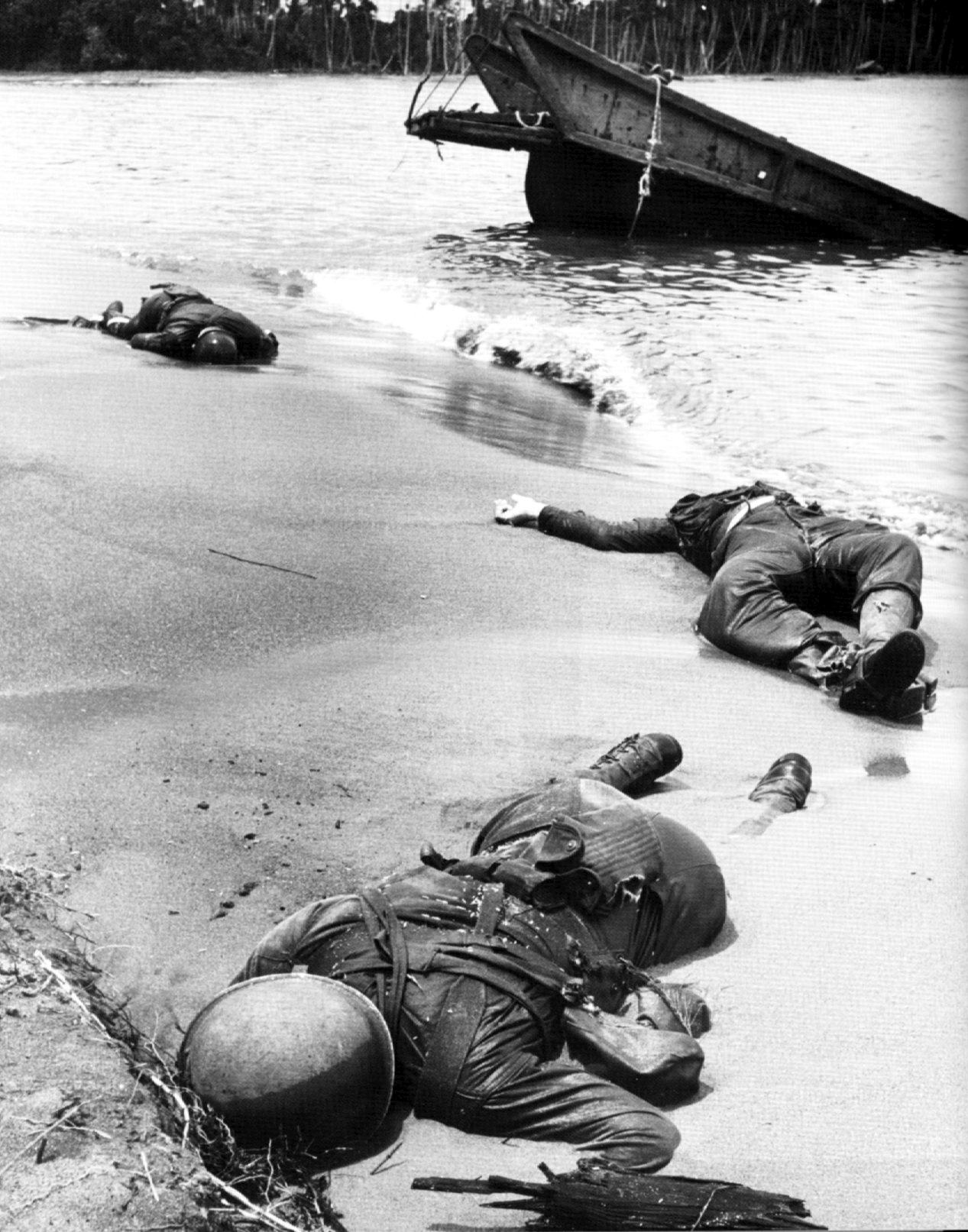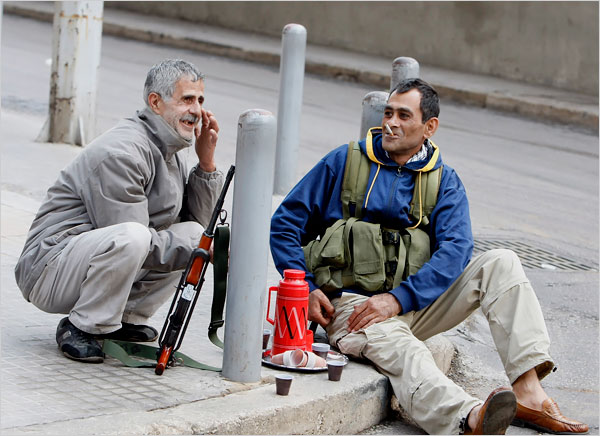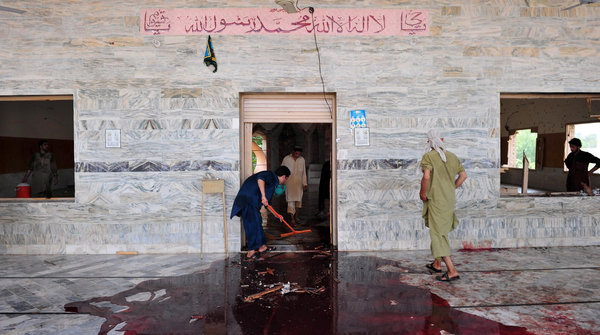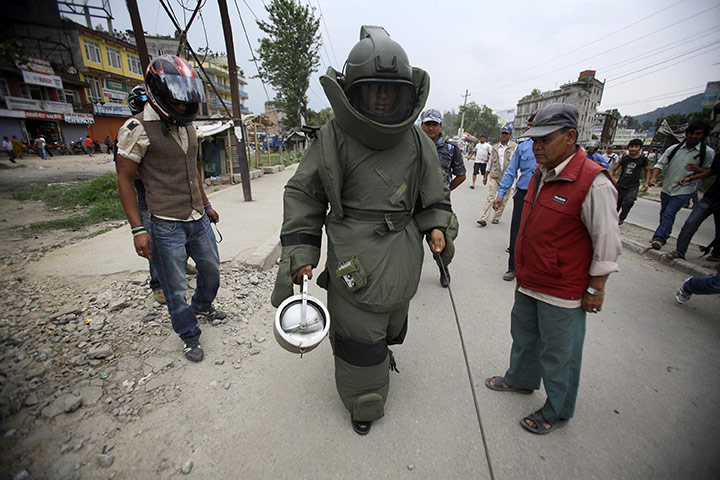The Banality of Violence
Robert Hariman / Northwestern University and John Louis Lucaites / Indiana University

In an earlier essay, “Bad Image, Good Art: Thinking Through Banality,” we made an argument for the appreciation of an aestheticized banality as an artistic resource that might be useful in visualizing the extraordinary ordinariness of everyday life. Those who commented on the essay challenged the notion that truly banal images could effectively represent everyday life, and the point is very well taken. Here we want to emphasize our commitment to banality as an aesthetic that operates precisely at the point of tension between the extraordinary and the ordinary, and to suggest how that point can become an aperture for exposing processes of “normalization.” In that first essay we addressed the problem of visualizing the economic recession; here we turn our gaze to to the problem of visualizing war and violence in the post-cold war era.
The good news is that war is killing fewer people now than in the first half of the twentieth century, and modern war kills fewer people proportionately than does warfare in premodern societies; and civil violence such as murder and mugging has been decreasing steadily around the globe with the spread of modernization. By contrast, the rates of death by conflict in primitive societies were staggering—roughly 15 percent of the population—and the carnage included torture, the slaughter of women and children, and genocide as relatively common practices. If violence was not quite the statistical norm, there was nevertheless a habituation to cruelty that was understood to be normal. This is not to deny the appalling rates of rape and domestic violence, gang and state warfare, and other forms of violence in our times, but it is notable that sexual and domestic violence has to be hidden, gang violence is contained to very specific localities, and state terrorism and other institutionalized violence is rationalized and denied. The conclusion seems clear: modernity has made human beings less violent.
Or not. While the relative body count has dropped over time, the expenditure on warfare has increased enormously since the end of the last world war at midcentury. And while the so-called “great” nation states have not engaged in direct military confrontations in a world of mutually assured destruction, it is hard to ignore the 5.4 million killed in the Congo (including mass rape and sexual mutilation), another 800,000 in Rawanda, and also the Balkans, Chechnya, and the dirty wars of Latin America, not to mention the 40,000,000 people who are currently displaced to other countries, usually by war and often to refugee camps that can become permanent stateless settlements. And let’s not forget the massive increase in spending on private security forces—and their significant escalation in weaponry and related technologies—which looks like something that was taken for granted by the Medicis and other elites accustomed to a culture of lawlessness. More could be said here, but the point is that rather than to celebrate a major step forward in moral progress, we might be better served by considering the possibility that we are experiencing the first waves of a new order of violence with its relatively benign features arriving first and its more vicious features arriving later.
The more one looks into the moral dilemma, the more one can see how the case for modernity depends on who is counting and what is being counted. Are drug wars to be considered wars? Is the war over if the camps still exist? Are prisons less violent than public beatings? And if something important is being missed in the calculation of moral progress, can it be seen? It is, of course, this last question that concerns us, for photography has long been an important medium for habituating civilian populations to wars experienced from afar. And in this context it is notable that those once dubbed “war photographers” are now called “conflict photographers,” an indication perhaps of a shift in perspective that warrants attention.
Conflicts are more common than wars, of course, but they are also less likely to share a common definition or narrative even if they are just as deadly for those being killed. One result of this is that conventions of war photography become less useful as photographers are now trying to make sense of scenes that are not so readily legible. Instead of Grant and his staff in the field, or Ike meeting with his troops in anticipation of the D-Day invasion, we are shown a truck bed full of child soldiers not likely to be restrained by the one adult who is driving the vehicle. In place of bodies on the fields of Gettysburg or on Buna Beach, we are shown a child looking at a pair of prosthetic limbs. In short, the transformation of war from major state conflict to a shadow state of globalized violence has required a refocusing of the camera’s lens both politically and morally.
Space precludes comprehensive consideration of the visual vocabulary that appears to be emerging out of this transformation, but one of its central components is the substitution of banality for drama. Drama provides heightened attention to the extraordinary as it emphasizes human action and volition. And violence, of course, is understood to be the extraordinary disruption of the normal. But how does one account for violence that has become so thoroughly normalized that it is either (a) untethered from specific political aims or easily identifiable leaders or martyrs that provide any kind of check on its ferocity or longevity (see Linfield, The Cruel Radiance), or (b) made by regime-made disasters in which military and other state powers are used to degrade civil society in an occupied area to near the point of collapse, and then keep it there (see Azoulay, The Civil Contract of Photography)? One strategy has been to complement or challenge familiar exemplars of wartime photography with images that underscore the utter banality of violence.
As we indicated in our first essay, the banality that concerns us points to the dull, ordinary routines of everyday life which normalize an attitude of habituation to the world around us and, at its worst, undercuts the impulse to change. To talk of the banality of violence is thus to consider the ways in which we all too easily accommodate to (and are accommodated by) the normalization of so-called “low-level violence.” If violence is typically understood to be spectacular, measured in respect to how it invades, appropriates, and otherwise invokes something like shock and awe, casting it in terms of its banality can underscore the gaps between a war or conflict’s purpose (if it has one) and the experience of everyday life. The troops leave to great fanfare, but someone then has to go home to an empty bed; snipers and suicide bombers are a constant threat, but a soldier may be preoccupied with brushing his teeth; homecoming reunions are uplifting, but bedrooms that are kept unchanged for children who will never come home call attention to how war’s effects include many decades of silent grieving. And when the war or conflict doesn’t have a recognized and sustainable purpose, representations of such banality become the final measure of its destructiveness. Banality can reveal not only the loss of life and limb (tragic enough in their own registers) but also how civil society is corrupted by making trauma routine and routines forms of extended violence.
Examples abound, but two should make the point. The first takes place in Beirut, 2008. Violence had once again erupted and the slide shows were awash with images of third world street violence replete with burning tires spewing oily smoke, all manner of debris strewn here and there, and young revolutionaries strutting their stuff in defiance of an oppressive regime. But then amidst such scripted and conventional images we find what may be the most disturbing image of all.

The caption reads, “After Shiite fighters seized control of parts of west Beirut, a gunman, right, took a break to drink coffee on a street corner.” The disorientation is palpable. The scene is the epitome of a worker’s coffee break: thermos, a smoke, a joke. It could be an image of civilization at its best: making the impersonal curb into a place of conviviality. And look at his feet: stylish leather loafers and no socks. See the military vest as a life jacket and he could be waiting for his boat to be put in the water. But of course they are not out for a pleasant afternoon on the water, but are obviously normal human beings who are nonetheless habituated to a cycle of violence that has them moving in and out of war on an hourly basis as if they were working at their day job.
The routinization of war takes many forms, but when it carries a tension between the ordinary and the extraordinary it can open up a space for much needed reflection and critical judgment. Consider the two photographs below. The first shows the aftermath of a suicide bombing outside of a Sunni mosque in Ghundai, Pakistan.

Although the effect of the explosion on those within must have been amplified by the brick walls, the solid construction no doubt saved many lives. But what is more notable is the apparent solidity within the local community that matter-of-factly gets on with the business and responsibility of living together. The river of blood has a deadening effect on those of us not accustomed to such events, but for those involved in the clean-up there appears to be no anguish at all. Indeed, the scene is devoid of any drama whatsoever. The bomb goes off, and out come the hoses and brooms with each person recognizing his or her function in getting the job done as if there just another everyday routine. The practicality of these ordinary people in responding to disaster is simultaneously admirable and stultifying. The scene appears too ordinary to be a picture of war, and yet one can only shudder at the thought that this passes for the alternative.
If the photograph was altogether unique one might challenge our reading of it as being esoteric, but there are many other images that tell the same or similar story. With the photograph below we move from the tragic to the ridiculous, but the aesthetic framework is unchanged.

The individual in the middle is a member of a bomb squad in Kathmandu, Nepal leaving the scene of a false alarm. He is carrying a pressure cooker, which apparently was the cause for the alarm. The image has a cartoon quality to it that makes it seem altogether silly. And yet notice how it captures the way in which any society can become habituated to monstrous distortions within everyday life. The overstuffed suit and massive headgear could be a metaphor for the national security state, but more to the point, the photograph is an allegory of how cycles of violence have become routine disruptions within civil society. Like the bystanders in the photo, we give the security apparatus momentary attention and then get on with the business of living, even though we have just seen something that appears alien and excessive. And so we become habituated to local adaptation rather than confronting systemic change, and the cycle of violence goes on unabated.
The conclusion here is a simple one, though perhaps no less important for being so. Banality carries the dual recognition that ordinary people adjust to violence and deprivation and of necessity can become accustomed to anything, and that this capacity for survival can be used against them. By documenting small gestures instead of dramatic events, photographs that draw upon banality as an aesthetic resource reveal what otherwise risks going unseen: how violence is being normalized. Or to put a bit differently, banality is the condition in which violence can be seen as violence rather than as a means to an end.
Image Credits:
1. Buna beach Life 1943
2. Beirut gunman coffeebreak
3. Bloody mosque
4. Bomb suit Kathmandu
Please feel free to comment.
A majority of the United States seems to be brainwashed by the media. Corporate conglomerates controlling what we see on every channel they own. A mindless thought process where the truth is hidden from the population because it doesn’t fit with the sponsors agenda and beliefs. Fortunate for the masses, lies the internet. A web of truth (and lies) that is unhindered with images of war, struggling humans and a hint as to how the world might come to its end. Scary visions of bloody remains and uncensored images, literature, and NEWS. A visual metaphor for the first amendment, and a dangerous place to reveal beliefs and hate.
I’m not saying the internet is the eye of the world, but it definitely allows us a peek into what the world is truly like. After 911, we lost our shelter — I was there — I was a Nurse, in charge of an ICU in NY on that day, and we waited for casualties. None came. Everywhere — on every TV was the banal repetition of the Towers, blazing, smoking, falling. The propaganda of Network coverage — “Show it until they puke! Get e’m riled up. Let’s go to war!”
This is what it appears to be in the course of how it is shown — brainwashing us into oblivion. Get the nation revved — Let those who were not there “feel our pain.” I have no problem sharing my pain with a person, it’s when the broadcasters force that pain down our throats unrelentingly. “Just in case you missed it — here it is again!”
The still photo’s that surfaced shortly after — A Jet, just meters away from striking the building — you know the impact is inevitable. There’s no surprise in it, but strangely, I couldn’t take my eyes off it. Knowing what had happened and the result that came of it — it became a moment frozen in time and will be the difference between life and death for those within Tower one — and two. A moment where if you could freeze your TV, you could get everyone out of those buildings and save thousands.
As a nurse, it’s my duty to care about others. Help those in need of care, and care about them from one human to another. I hate violence, but I have no control over the world (as no one else does). It’s something we all have to cope with. Shocking images are there for a reason — to show how non-violent you are! They are there to help recognize the fear of violence within ourselves and understand how the world outside is.
In the grand scheme of things, we have been a sheltered nation. One who’s been hiding under their mother’s skirt for years. I think it’s important to show what violence does — not being violent ourselves, but as a result. It most certainly isn’t pretty, but it does make it’s point.
Thank you for your fascinating post! While reading, I couldn’t help but think of the numerous other depictions of violence that are emitted through media everyday, specifically video games and internet message boards that advocate “gore” threads, and how with interactivity with the violence, is an attribute to it becoming banal in media and banal to the audience receiving the images. If children are growing up playing video games where the objective is to kill an enemy with a head shot, much like a real soldier may have to do in a real combat situation to protect their or someone else’s life, the fact that the user is the one conducting the action –pulling the trigger/pushing the button and killing the enemy – causes these images presented in media to be reminiscent of a past experience, only it’s in the digital realm. A kid can say, “I did something just like that in the game I was playing yesterday,” and while they do recognize that the image from the news is real, the fact that they participated in a simulation of similar violence diminishes the effects of the image.
Another factor I see contributing to society viewing violence as banal is the is message boards on sites like the controversial 4chan.com, that request users for images, animated GIFs, or videos depicting extreme violence or death. A user will start a thread and call it a “gore” thread, asking other anonymous users to post content depicting violent acts one normally wouldn’t see on television, or most online resources unless they specifically are searching for it. Considering that as of May 2011, estimates show that 4chan.org has approximately 18 million monthly users (TechCrunch.com), there is a clear indication that the digital generation is not at all shying away from violent images.
The way simulated violence and the accessibility to violent images is becoming more commonplace within society, along with the discussion you brought up about the expenditure of violence rising since WWII, the media is going to show that society is becoming adjusted to seeing violent images. It is troubling that this is leading to violence as becoming “normalized,” but I’m not sure a solution would be to not reveal these images that depict banality in war. It leads me to question if it is actually better for society to witness more violent images as a way to combat this banality. Somewhat as a tool to teach the world? It’s an extremely morbid thought, but if media is portraying war, violence, and death with banal images, where is there to go? The cycle of violence may go unabated, especially with so many outlets for images of it to be absorbed.